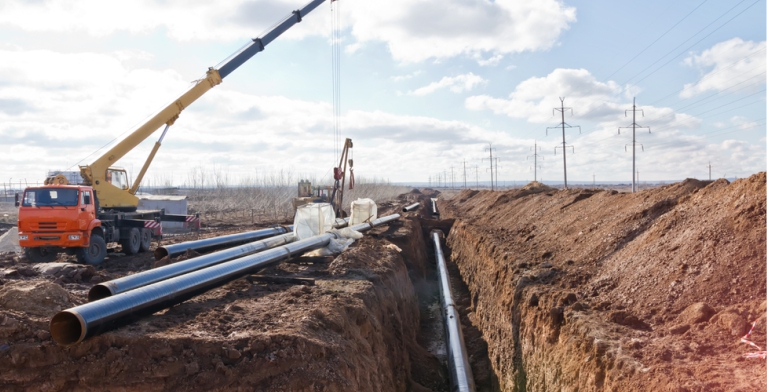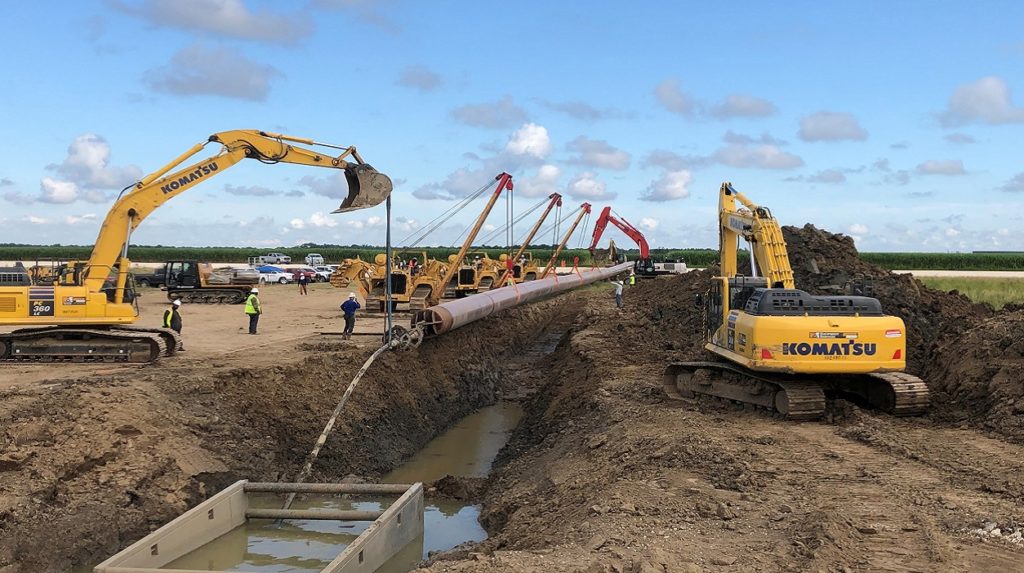Why You Should Consider Underground Work With Creek Pipe trenching services
Wiki Article
The Significance of Pipeline Construction: Exploring the Solutions Offered in the Market
Pipeline construction is a critical part of modern facilities. It promotes the transport of crucial resources like oil, gas, and water. The industry incorporates different solutions, consisting of preparation, site preparation, and setup. Each stage requires precision and adherence to security standards. As communities depend on these systems for their incomes, recognizing the complexities of pipe construction discloses its value and potential obstacles. What variables affect the success of these projects?Overview of Pipeline Construction Solutions
Pipeline construction solutions encompass a variety of customized tasks created to assist in the installation of pipes for transporting numerous compounds, consisting of oil, gas, and water. These services commonly include site prep work, excavation, installation of pipeline segments, and backfilling. Experienced labor and sophisticated devices are basic for ensuring each stage is carried out with precision and safety.Safety procedures are paramount, as these projects commonly involve collaborating with dangerous materials and in challenging settings. Quality assurance steps determine that the pipelines meet market requirements and regulations. In addition, the services may entail trenchless modern technology, which reduces surface disruption.Environmental considerations play a considerable role in pipeline construction, needing evaluations and mitigations to safeguard bordering ecological communities. Overall, pipe construction services are vital for developing the facilities necessary for energy and water distribution, supporting both financial growth and social demands.Planning and Design in Pipeline Projects
Effective preparation and design are crucial components of effective pipe projects, ensuring that all elements are thoroughly dealt with before construction begins. This phase includes complete feasibility researches that analyze the technological, financial, and ecological variables affecting the task. Designers and designers work together to develop detailed plans that outline the pipeline path, products, and construction techniques, aligning with regulatory demands and market standards.Advanced software application and modeling techniques are usually employed to replicate different situations, maximizing the style for efficiency and safety. Environmental influence analyses are carried out to alleviate prospective harm to ecological communities and neighborhoods, mirroring a commitment to sustainable methods. In addition, stakeholder engagement is necessary, fostering communication and addressing issues from influenced parties. Eventually, effective planning and design established the foundation for a pipe job, minimizing threats and ensuring a structured construction procedure, eventually contributing to the general success of the procedure.Site Preparation and Excavation
Detailed site preparation and excavation are important actions in the pipeline construction process. This phase entails a comprehensive analysis of the land where the pipeline will certainly be set up. Task groups conduct studies to recognize dirt types, topography, and existing utility lines to ensure a safe and efficient excavation. Proper site preparation lessens ecological impact and assists in smoother construction operations.Excavation follows, where heavy machinery is used to eliminate dirt and rock, producing a trench that fulfills the defined depth and width for the pipeline. This process should comply with safety guidelines and environmental guidelines to stop damages to bordering ecosystems.Additionally, erosion control measures are executed to stabilize the site during and after excavation. Effective site prep work and excavation add significantly to the total success of pipeline jobs, laying a solid structure for the succeeding phases of construction.Pipeline Installation Techniques
Pipeline installation techniques are necessary for the effective execution of facilities jobs. 2 noticeable methods consist of trenchless innovation, which decreases surface disruption, and the open-cut excavation process, known for its simple technique. Each strategy uses distinctive benefits and factors to consider depending on job demands and ecological variables.Trenchless Modern Technology Approaches
While conventional approaches of pipeline installation often involve extensive excavation, trenchless technology methods supply a much more effective and environmentally pleasant choice. These cutting-edge strategies, such as horizontal directional drilling and pipeline bursting, minimize surface interruption by enabling the installment of pipes without extensive excavating. This not just minimizes the ecological influence however additionally significantly lowers labor and reconstruction expenses. Trenchless approaches assist in the installation of pipelines in metropolitan areas where typical excavation would be not practical or harmful to existing framework. In addition, these methods can fit various soil types and conditions, making them functional solutions for pipe construction. Eventually, trenchless modern technology represents a substantial advancement in the pipe market, promoting sustainability and operational effectiveness.
Open-Cut Excavation Refine
Open-cut excavation remains an essential method in pipeline installation, identified by the direct excavation of a trench to lay pipes. This technique includes eliminating dirt and various other materials to create a trench of enough deepness and width, enabling the placement of pipes at the needed grade. Open-cut excavation is often preferred for its cost-effectiveness and simplicity, specifically in areas with secure dirt problems. Nonetheless, it can disrupt surface area tasks and calls for mindful planning to manage web traffic and ecological effects. Safety procedures you could check here should be carried out to shield employees and close-by framework throughout the excavation procedure. Generally, while open-cut excavation might not be appropriate for all terrains, it remains a widely utilized technique in pipe construction.Examining and Quality Control
Examining and high quality assurance are essential components in pipeline construction, making sure that setups satisfy well-known security criteria and efficiency requirements. Various assessment techniques and methods are used to examine material quality and adherence to regulatory compliance. This organized method aids recognize possible issues prior to they escalate, securing the honesty of the pipe system.
Evaluation Techniques and Approaches
Evaluation techniques and approaches are essential parts in ensuring the stability and safety and security of pipe construction. Various strategies, including aesthetic evaluations, ultrasonic testing, and radiographic exams, are utilized to detect issues and confirm top quality. Visual examinations permit the recognition of surface abnormalities, while ultrasonic screening utilizes acoustic waves to evaluate wall surface density and situate flaws internally. Radiographic assessments include X-rays or gamma rays to generate pictures of the pipeline's framework, exposing surprise problems. In addition, stress testing is performed to review the pipe's integrity under functional conditions. These methods jointly contribute to an extensive understanding of the pipeline's condition, making it possible for prompt maintenance decisions and making certain conformity with industry criteria. Efficient evaluation is critical for avoiding failures and promoting long-term operational security.Security Criteria Compliance
Making certain compliance with safety and security requirements is critical in pipeline construction, as it straight impacts the job's total top quality and reliability. Following well-known regulations and standards warranties that construction techniques alleviate threats linked with pipeline installation and operation. Creek Pipe reviews. Extensive testing procedures, including non-destructive screening and pressure evaluations, are crucial in validating that pipes can withstand the operational anxieties they will certainly run into. Quality control steps are additionally vital, as they establish a structure for constant tracking and analysis see here throughout the construction procedure. By focusing on security criteria conformity, business not just protect employees and the setting however also enhance the honesty of the pipe, inevitably bring about lasting operational success and public rely on the facilitiesMaterial High Quality Assessment
Material top quality evaluation plays a considerable duty in the overall honesty of pipe construction. This process entails extensive screening and quality guarantee procedures to ensure that materials satisfy sector standards and requirements. Different tests, including tensile stamina, corrosion resistance, and weld integrity evaluations, are carried out to identify any possible weak points. A detailed analysis not only guarantees the efficiency of the pipe yet also enhances safety and security and sturdiness over its life-span. In addition, executing quality assurance methods helps reduce risks related to product failures, which can lead to pricey repairs and environmental threats. By focusing on material top quality examination, firms can ensure conformity with regulative demands while cultivating self-confidence among stakeholders in the dependability of their pipeline systems.Repair And Maintenance Providers
Upkeep and repair service services play a crucial role in the long life and effectiveness of pipeline systems. These services include regular assessments, fixing, and restorative activities to address deterioration, leaks, and other issues that might develop in time. Experienced service technicians make use of sophisticated innovations such as ultrasonic testing and clever pigging to keep track of pipe stability, making certain that any kind of possible issues are recognized early.Additionally, maintenance programs often include set up safety nets designed to boost system integrity and lower the likelihood of unanticipated failings. Repair solutions may entail the substitute of damaged areas, securing leaks, or utilizing trenchless innovation for marginal interruption.Environmental Conformity and Precaution
Pipeline systems not only call for recurring repair and maintenance to operate efficiently but more helpful hints also need to adhere to stringent ecological compliance and security steps. These guidelines are essential for decreasing environmental influence and making certain public safety and security. Firms in the pipe construction market implement extensive environmental evaluations prior to task initiation, recognizing possible risks to wild animals and ecosystems.Furthermore, adherence to safety methods safeguards workers and surrounding communities. This consists of regular training on emergency reaction and spill prevention techniques.To keep conformity, industries utilize keeping an eye on technologies to spot leakages and other abnormalities in real-time. Ecological monitoring plans are often developed to detail steps for addressing unanticipated issues throughout construction.Ultimately, stringent adherence to ecological conformity and safety steps not only fulfills legal obligations yet additionally promotes lasting practices within the industry, promoting a balance in between facilities advancement and ecological stewardship.Frequently Asked Inquiries
What Occupation Opportunities Are Readily Available in Pipeline Construction?
Occupation opportunities in pipe construction encompass duties such as job managers, engineers, welders, and security examiners. These positions call for varied abilities, offering paths for development in a crucial market of facilities development and power circulation.

Just How Do Pipeline Projects Influence Citizen Communities?
Pipeline projects significantly impact neighborhood neighborhoods by influencing financial growth, providing work chances, and improving facilities. Nevertheless, they might also increase issues about ecological effects, land usage, and potential disturbances to neighborhood communication and natural ecological communities.
What Technology Is Used in Modern Pipeline Construction?
Modern pipeline construction utilizes advanced technologies such as GIS for mapping, drones for airborne surveys, and automated welding systems to improve efficiency, security, and accuracy, eventually facilitating the efficient transport of resources across various surfaces. Creek Pipe trenching services.How Are Pipeline Construction Prices Approximated?
Pipeline construction costs are approximated via in-depth assessments of materials, labor, devices, and regulatory needs. Variables like surface, job size, and ecological considerations additionally substantially affect the general budget and financial preparation for construction.What Are the Biggest Challenges in Pipeline Construction Projects?
The largest challenges in pipe construction jobs include governing compliance, ecological problems, logistical concerns, securing funding, and handling labor lacks. Each aspect can greatly affect timelines and spending plans, complicating the total implementation of the task.Report this wiki page